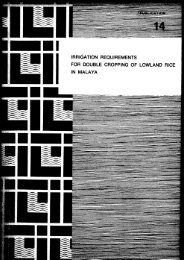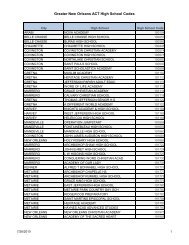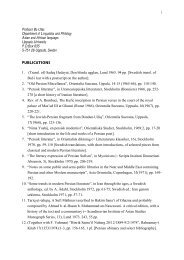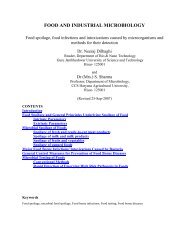On the Future of Indigenous Traditions - Munin
On the Future of Indigenous Traditions - Munin
On the Future of Indigenous Traditions - Munin
Create successful ePaper yourself
Turn your PDF publications into a flip-book with our unique Google optimized e-Paper software.
organizing <strong>the</strong>ir social governance system mainly, by not going into <strong>the</strong> details <strong>of</strong> <strong>the</strong><br />
different aspects <strong>of</strong> <strong>the</strong> customary system or law <strong>of</strong> <strong>the</strong> Adivasis <strong>of</strong> Jharkhand.<br />
Anthropological scholars have done most objective studies <strong>of</strong> <strong>the</strong> Adivasi<br />
communities in which we find reference to <strong>the</strong>se customs and practices. Among <strong>the</strong><br />
most famous are S.C. Roy, W.G. Archer and K.S. Singh.<br />
In <strong>the</strong> study <strong>of</strong> <strong>the</strong> political system <strong>of</strong> <strong>the</strong> Adivasis, any reference in <strong>the</strong> reconstruction<br />
<strong>of</strong> pre-colonial customary social governance system <strong>of</strong> <strong>the</strong> Adivasis must be read<br />
through <strong>the</strong> distorting prism <strong>of</strong> colonial records, which scholars have used. In<br />
Jharkhand, villages were organized on <strong>the</strong> basis <strong>of</strong> lineages which jointly managed<br />
resources as <strong>the</strong>y collectively own <strong>the</strong> land and forest. This management system <strong>of</strong> <strong>the</strong><br />
Adivasis varied across regions and between different communities. How did this<br />
management system co-inside with <strong>the</strong>ir own social system?<br />
2.3.1. Division <strong>of</strong> Role and Responsibilities <strong>of</strong> leaders for Governance among<br />
Adivasis according to <strong>the</strong>ir customary laws<br />
For example, among <strong>the</strong> Mundas <strong>the</strong> headman is called <strong>the</strong> ‘munda’ and <strong>the</strong> priest <strong>the</strong><br />
‘pahan’, while among <strong>the</strong> Oraons, <strong>the</strong> headman is called <strong>the</strong> ‘mahto’ but <strong>the</strong> priest is<br />
still <strong>the</strong> ‘pahan’. The pahan was usually drawn from <strong>the</strong> head <strong>of</strong> <strong>the</strong> lineage which<br />
founded <strong>the</strong> ‘khunt-katti’ 39 hatu - village, and it was only later, if at all, that <strong>the</strong><br />
<strong>of</strong>fice <strong>of</strong> <strong>the</strong> headman was separated from that <strong>of</strong> <strong>the</strong> pahan. Gradually <strong>the</strong> secular and<br />
religions function became distinct, and <strong>the</strong> next most prominent man was <strong>the</strong> munda<br />
(in <strong>the</strong> case <strong>of</strong> Oraons it was <strong>the</strong> mahto) responsible for <strong>the</strong> secular affairs <strong>of</strong> <strong>the</strong><br />
village <strong>of</strong> <strong>the</strong> community. Here nei<strong>the</strong>r <strong>the</strong> munda nor <strong>the</strong> pahan has any right<br />
superior to those <strong>of</strong> o<strong>the</strong>r descendents <strong>of</strong> <strong>the</strong> original founders <strong>of</strong> <strong>the</strong> village, <strong>the</strong><br />
39 Khunt-katti hatu: Village which has a status <strong>of</strong> khunt-katti. Khunt or khut: meaning ei<strong>the</strong>r <strong>of</strong> <strong>the</strong><br />
two branches <strong>of</strong> <strong>the</strong> village family. Khuntkatti : where <strong>the</strong>re is no zamindari – land lordship and no<br />
individual owners <strong>of</strong> a village and all <strong>the</strong> land is legally owned by <strong>the</strong> village community.<br />
(Encyclopaedia Mundarika, page 2382. By Fr J. H<strong>of</strong>fmen published in 1960 in 16 volumes)<br />
Normally in Khuntkati villages, villages are divided into Munda Khunt, Manki khunt, Pahan Khunt and<br />
Raiyats.<br />
34

















